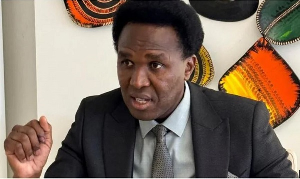The harvest is plenty, yet everybody is hungry. That philosophically, is the story of Ghana. Ghana sits on some of the richest mineral deposits and other huge foreign exchange earning resources in the world. Yet poverty stalks the land.
A new study titled, ?The Industrial Potential of Ghana, prepared by Onua Amoah, a member of the ?Big Six? lists 25 foreign exchange earning minerals and chemicals that are going waste, while past and present governments have been traveling around the world, cap in hand begging for foreign donations.
According to a report carried by the ?Public Agenda?, last week, Onua Amoah who is an Industrialist researcher and five others ? Mr. Robert Wood, an Agricultural Engineer, Professor Frimpong Boateng, Cardio thoracic Surgeon, Col. K.A. Jackson, Energy Conservation Technology Researcher, Rev. Dr. Mensah Otabil, Chancellor of Central University and Dr. K.A. Owusu-Ansah, Director of Council for Scientific and Industrial Research (CSIR) launched the Centre for Technology-Driven Economic Development (CTED) to move the country away from the current import-led economic development strategy to a technology-driven economic development that would spur industrialization and enable the country attain middle-income status by 2010?.
To attain middle-income status by 2010, experts estimate that the manufacturing sub-sector should grow at an average rate of 12 per cent per annum for five years. ?This is why we at CTED have put it upon ourselves to lay bare the mineral resources of Ghana, but also to show how to transform these resources into finished goods through industrialization in order to halt the economic decline?.
?As a people, we are so much concerned about purchasing what other people have produced such that, we have refused to recognize that there are abundant resources in our land. The resources of this country are in our lands, but everybody is abandoning the land and coming to the cities to buy and sell,? Amoah lamented.
Amoah said Ghana has natural resources, ranging from chemicals and minerals such as limestone, bauxite, iron ore, ordinary clay, kaolin white clay, magnesium carbonate, gypsum, feldspar, alum, titanium and granite.
There are about 435 million tons of limestone, which is used to manufacture cement, sodium carbonate, calcium chloride, quick lime, glass, paper, rubber and plastics etc.
Ghana also has 540 million tones of bauxite, which is used in aluminium, grinding materials and aluminium chemicals. Besides, there is 1.4 billion tons of iron ore deposited in various parts of the country. Iron ore is used in producing iron and steel, automobile and railway industries. Ghana also boats of 745 million tons of clay or ordinary clay, used in the building, clinker and ceramic industry, white clay deposits are estimated at 100 million tons, while kaolin, used for surface coating soap, porcelain ware and ceramics are in the quantity of 600 million tons.
Another mineral, magnesium carbonate used in producing pharmaceuticals, fertilisers, refractory products, thermal insulating materials, filter, paper, paints, printing ink etc. has over 72 million tons.
Perhaps one commodity that has unlimited raw material is salt. On the West Coast of Africa, only Ghana and Senegal have the normal seawater that is used to produce salt for industrial and domestic purposes. Among the industrial uses of salt are sodium hydroxide, chlorine, silicon wafers, magnesium sulphate and sodium sulphate. In spite of its numerous uses, Ghana has not taken full advantage of developing salt into a major exchange earner to the extent that salt consumers import the commodity from Brazil and Argentina.
The list is unending. Ghana also has more than 100 million tons of fine sand, also called (silica) used in manufacturing glass, solar (chips) cells, chinaware, clinker, ferrosilicon etc.
The study said for instance that the prices of electronic grade silicon, which is made from quartz, which are found mostly in pellet forms in many parts of the country, could be purified with common salt. Sadly, this abundant resource is yet to be tapped.
The physic nut or Jatropha Curcas is one plant that has industrial and commercial uses, but has only been used in Ghana as a hedging and boundary plant. It has been discovered to have bio-diesel that can power various engines. It can also be used as organic manure rich in nitrogen, phosphorous, potassium and ammonium nitrate. Other uses include pharmaceuticals, cosmetics. Candles, electronic and telecommunications, textile, leather paints and adhesive.
Recently, Anuanom industries manufacturers of Klinda detergent produced diesel from the Jatropha seed, which was used to power a car in Accra.
Among the cash crops Ghana has not taken advantage of are, the castor plant, used for pharmaceuticals, fertilisers, technical oils, cosmetics and detergents. Even okro, which is commonly used for cooking soup, can be used in producing sugar, according to the researcher.
Other crops with industrial products include, plantain, yam, cocoyam, mini seeds, banana, corn, pineapples, groundnuts and citrus fruits.
Surprisingly, even egushie (kurbis) used in preparing palava sauce can be used in making cooking oil, margarine and pharmaceuticals.
But that is as far it goes. Onua Amoah was unhappy that despite the presence of these plants and minerals in abundance, no concerted effort has been made to utilise them for national development. ?Let me make it clear that only few of these numerous natural resources have been researched and their quantities determined. The existence of most of them is not known at all?.
The legitimate question that follows from this sketch is why is Ghana heavily indebted and poor country when she has all the mineral resources to kick-start the economy.
Dr. Kofi Amanor Owusu-Ansah, a member of the ?New Big Six? and Director of the Council for Scientific and Industrial Research (CSIR) said Ghana?s low industrialisation stems from the fact that 45 years after independence the leaders of the nation have failed to recognize the importance of research and development in economic planning.
Citing Malaysia and South Korea as examples, Dr. Owusu-Ansah said in 1999, the two countries allocated 2.5 per cent of Gross Domestic Product (GDP) each to research and development. An allocated 3.5 per cent of GDP to research and development in the same year, while Ghana only managed 0.03 per cent for research and development. The lack of funding for research means some of the 13 units of the CSIR are being underutilized.
Dr. Owusu-Ansah said even with their rising level of development South Korea in 2000 reduced budgetary allocation for all sectors except for science and technology. Japan increased their budgetary allocation from 3.5 per cent to 5 per cent GDP to science and technology within the same year.
?Japan, Malaysia, South Korea and indeed all developed countries have realized that there is linear relationship between economic growth and research and development?, Dr. Owusu-Ansah said.



















